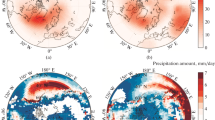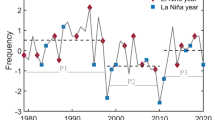Abstract
The main subject of this article is to comment on the issue of storminess trends derived from the twentieth century reanalysis (20CR) and from observations in the North Atlantic region written about in Wang et al. (Clim Dyn 40(11–12):2775–2800, 2012). The statement that the 20CR estimates would be consistent with storminess derived from pressure-based proxies does not hold for the time prior to 1950.
Similar content being viewed by others
Avoid common mistakes on your manuscript.
The authors state in the abstract of their article that “for the North Atlantic-European region […] the twentieth Century Reanalysis (20CR) cyclone trends are in agreement with trends in geostrophic wind extremes derived from in-situ surface pressure observations”. However, this assertion is unsupported; we do not know any publication showing storminess time series over the North Atlantic-European region that confirm such an agreement. Instead the curves known to us (e.g. Schmith 1995; e.g. Alexandersson et al. 1998; e.g. Alexandersson et al. 2000; e.g. Matulla et al. 2008; e.g. Wang et al. 2009) all show a markedly different development. To illustrate this fact, we have assembled Fig. 1, which features time series of Northeast Atlantic storminess derived from the 20CR dataset and observations. According to the assertion of Wang et al. (2012) these curves should be in agreement with their results over the North Atlantic.
Standardized and lowpass filtered annual 95th percentiles of geostrophic wind speeds over the North Atlantic. The green line denotes the time series derived after Alexandersson et al. (2000), the red line the same, but for the 20CR dataset (Compo et al. 2011). The blue line has been extracted from Wang et al. (2009)
Figure 1 shows standardized time series of annual 95th percentiles of geostrophic wind speeds over 10 triangles in the Northeast Atlantic derived from MSLP observations after Alexandersson et al. (1998, 2000), Wang et al. (2009) (data taken from their Fig. 2), and 20CR (Compo et al. 2011) for the period 1881–2004. Details can be found in Krueger et al. (2013). The curves were low-pass filtered. There is a striking resemblance between the curves from Alexandersson et al. (1998, 2000) and Wang et al. (2009). The curves show strong decadal variability but no obvious long-term trend. As stated in Krueger et al. (2013), 20CR-geostrophic storminess deviates to a large extent from the observation-based curves in the earlier decades. After about 1950 the curves converge which is also confirmed by Fig. 1. Due to the large deviations in earlier years the long-term trend is different. Thus, using the simple method of geostrophic wind calculations on both data from a fixed set of stations as well as from reanalyses gives no overall agreement, but important differences when going back in time. As discussed in Krueger et al. (2013), these differences are likely due to inhomogeneities in the 20CR dataset before the 1950s.
Furthermore, Fig. 12a in Wang et al. (2012) was meant to illustrate an agreement between 95th winter percentiles of geostrophic wind speed derived from observations (Wang et al. 2009) and the cyclone activity index of the current article over the North Sea area. However, the figure illustrates that a comparison of both measures is not applicable here, because the graphs do not agree with each other—only the long-term linear trends seem to agree. The given correlations between the NAO and 95th percentile of geostrophic wind speeds (0.79) and the cyclone activity index (0.11) indirectly show this disagreement. Unfortunately, a direct correlation between the curves of Wang et al. (2012) and Wang et al. (2009) was not given.
Even if we object to the assertions in Wang et al. (2012), we do not question the merits of the 20CR project, nor do we claim that the geostrophic winds, on which the storm proxies are based upon, are completely free of inhomogeneities in their early years.
References
Alexandersson H, Schmith T, Iden K, Tuomenvirta H (1998) Long-term variations of the storm climate over NW Europe. Glob Atmos Ocean Syst 6(2):97–120
Alexandersson H, Tuomenvirta H, Schmith T, Iden K (2000) Trends of storms in NW Europe derived from an updated pressure data set. Clim Res 14(1):71–73
Compo G, Whitaker J, Sardeshmukh P, Matsui N, Allan R, Yin X, Gleason B, Vose R, Rutledge G, Bessemoulin P et al (2011) The twentieth century reanalysis project. Q J R Meteorol Soc 137(654):1–28
Krueger O, Schenk F, Feser F, Weisse R (2013) Inconsistencies between long-term trends in storminess derived from the 20cr reanalysis and observations. J Clim 26(3):868–874. doi:10.1175/JCLI-D-12-00309.1
Matulla C, Schöner W, Alexandersson H, von Storch H, Wang X (2008) European storminess: late nineteenth century to present. Clim Dyn 31(2):125–130
Schmith T (1995) Occurrence of severe winds in denmark during the past 100 years. In: Proceedings of the sixth international meeting on statistical climatology, pp 83–86
Wang X, Zwiers F, Swail V, Feng Y (2009) Trends and variability of storminess in the Northeast Atlantic region, 1874–2007. Clim Dyn 33(7):1179–1195
Wang XL, Feng Y, Compo G, Swail V, Zwiers F, Allan R, Sardeshmukh P (2012) Trends and low frequency variability of extra-tropical cyclone activity in the ensemble of twentieth century reanalysis. Clim Dyn 40(11–12):2775–2800. doi:10.1007/s00382-012-1450-9
Author information
Authors and Affiliations
Corresponding author
Rights and permissions
About this article
Cite this article
Krueger, O., Feser, F., Bärring, L. et al. Comment on “Trends and low frequency variability of extra-tropical cyclone activity in the ensemble of twentieth century reanalysis” by Xiaolan L. Wang, Y. Feng, G. P. Compo, V. R. Swail, F. W. Zwiers, R. J. Allan, and P. D. Sardeshmukh, Climate Dynamics, 2012. Clim Dyn 42, 1127–1128 (2014). https://doi.org/10.1007/s00382-013-1814-9
Received:
Accepted:
Published:
Issue Date:
DOI: https://doi.org/10.1007/s00382-013-1814-9





